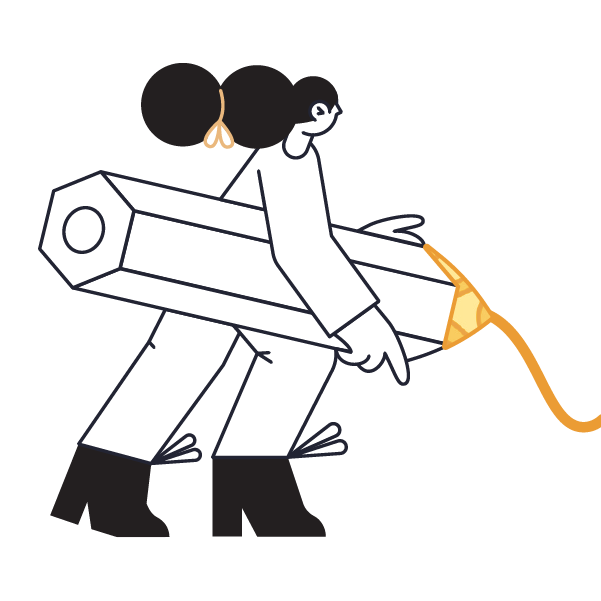A Guide to Using Graphic Novels to Teach Difficult Subjects

Illustration is a powerful aid, but one that is often phased out with age. Students move from picture to chapter books, animated cartoons to film. However, highly visual text—graphic novels and comics—have a place beyond early childhood.
Emily Oliver works with PositiveNegatives, a U.K.-based organization that creates comics to highlight untold stories, like those of migrants and refugees. She emphasized the influence that imagery can have on a reader’s perception of a story and the greater lessons within it.
“Words come with a lot of baggage. As soon as we hear the words ‘refugee,’ ‘migrant,’ ‘asylum seeker,’ we will all have a load of other associations,” Oliver said.
“They might be positive or negative, but when you start with visuals, and we begin to really see someone beyond those words, then sometimes that can really build empathy, compassion, perhaps even critical consciousness and humanity.”
From making the text of Shakespeare more accessible and visual to exploring the horrors of the Holocaust using mice, cats and pigs, graphic novels create powerful learning opportunities.
Navigate through the sections below to learn more about how to introduce graphic novels to children and for book recommendations:
Why Are Graphic Novels an Effective Tool to Discuss Difficult Subjects?
Dr. Michelle Falter, assistant professor of English education at North Carolina State University, described the dissonance between common perceptions of graphic novels and reality in a Cult of Pedagogy teacher roundtable.
“There is a stereotype that graphic literature is a lesser form of writing. This is absolutely untrue,” Falter said. “You have to see images and words work together, and when and why authors chose to put them together in a frame.”
Graphic novels are effective reading comprehension tools because they:

PROMOTE VOCABULARY AND LANGUAGE USE
Graphic novels utilize more literary devices, such as fonts, onomatopoeia and panels, that communicate the author’s specific choices and prompt discussion.

ARE MULTIMODAL
Multiple literacies in one medium facilitate understanding of complicated ideas and reduce text load.

ENGAGE RELUCTANT READERS
Illustration and motion provide new access points to stories, plus new contextual cues.

ARE ACCESSIBLE FOR ENGLISH LANGUAGE LEARNERS (ELLS)
A lighter text load and imagery can help students who are not fluent in English engage with the story.
This accessibility also makes graphic novels a good entrance point for conversations about extremely difficult subjects, like trauma, loss and conflict.
As a framing device, Oliver notes the two primary ways children see themselves in the story Ola by Asia Alfasi. Ola is a smart, popular girl navigating the difficulties of adolescence while also keeping a big secret: She is an undocumented immigrant.
For some students, Ola’s story and her fears surrounding her citizenship status mimic their own. And they rarely see their experiences in the media or have the opportunity to talk about it. Responses to Ola are filled with students who say they see themselves in Ola and her story, Oliver said, and never thought they would.
But Ola’s story is also the story of a young girl experiencing boy troubles and school stress. These universal themes tie other readers to Ola in a way they may have not expected.
Dr. Benjamin Dix, author of Vanni: A Family’s Struggle Through the Sri Lankan Conflict, describes this concept when retelling his experiences and taking the stories of war to classrooms.
“The kids really get it. They do a workshop with us, and then the next day they come back in and they have questions about Antoni, rather than about a statistic,” Dix said. “This is someone’s brother. They can empathise with that.”
FAQ for Parents and Educators About Graphic Novels
Graphic novels are frequent targets for book banning, and their nontraditional nature could prompt concerns about pedagogical efficacy or age appropriateness. Consult some of the resources below for guidance and more information on introducing graphic novels to children.
How do I know if this graphic novel is age appropriate?
Read the entire book to determine if the themes and language used are appropriate for your child or classroom’s age and reading level.
You can also use third party evaluations of age level to guide the process. Common Sense Media has age recommendations from parents and children and content warnings for many titles. Publishing houses and book sellers also often list age ranges for books on their sites.
Are themes like addiction and trauma too serious for comics?
One benefit of comics and graphic novels is that art and motion provide needed brightness and levity to trauma.
“The people we speak with, who have the most traumatic stories, say that lightness or humor is one of the important things that they want to convey alongside that,” Oliver said. “That’s how they cope. That’s who they are, and it’s able to do both of those, even just within one single image.”
I’m not an English teacher. Can I use graphic novels and comics in my class?
There are plenty of cross-curricular learning opportunities with graphic novels. Oliver pointed to a few of PositiveNegatives’ projects as examples.
Maths of Migration is a lesson plan accompanying the animation North Star Fading, the story of four Eritrean refugees who fled their homes. The lesson plan takes a STEM approach: Students examine the data of migration in Google Sheets and practice their math skills to learn more about trends.
What if I experience pushback from parents or administrators?
Consult your school’s guidelines in advance of selecting any reading material for your students. Are there specific rules in place about language and content themes? Is there an approval process for content that may be challenged?
The Harvard Graduate School of Education recommends that teachers have a clear reason for their book selections and do research before introducing it to the classroom. Other recommendations include communicating with parents in advance about the book and creating a plan with the principal in advance in case of complaints.
Additional guidance for graphic novels in the classroom can be found from the following organizations:
- How to Manage Challenges by the Comic Book Legal Defense Fund
- The First Amendment in Schools by the National Coalition Against Censorship
- First Amendment and Censorship by the American Library Association
- The Students’ Right to Read by the National Council of Teachers of English
Graphic Novel Activities for Children
Like other books, graphic novels are an opportunity to teach children about story structure and elements. However, Falter said that the very nature of graphic novels requires a different approach than traditional books.
“I think the worst thing you could do with teaching a graphic novel is teach it like a print-based text,” she said. “If you just focus on the story, and not on how the story is constructed through frames, colors, angles, word bubbles, etc., you are missing the point.”
Below are a few activities that parents and educators can pair with graphic novels to facilitate active reading.

Panel Re-Sort
Practice storytelling structure, sequencing and contextual inference.
How-to: Take a sequence of panels from a section in a graphic novel and cut them out. Mix the panels up, and have students put them in order and justify their process. This activity comes from the Buffalo and Erie County Public Library (PDF, 13 KB).

Character Design
Practice character development, archetypes, testing assumptions and emotive inference.
How-to: Give students images of different heroes and villains from graphic novels. Ask students to identify expressions, clothing and colors used. Can students tell who is a hero and who is a villain solely from visual clues? This activity comes from Scholastic’s A Guide To Using Graphic Novels With Children and Teens (PDF, 6.3 MB).

Fill in the Blanks
Practice contextual inference and storytelling structure.
How-to: Give students a set of comics or graphic novel panels with empty speech bubbles. Ask them to look at the pictures, imagine a story that fits and fill in the words themselves. This activity comes from Big Brothers Big Sisters Independence (PDF, 601 KB).

Make-Your-Own Graphic Novel
Practice the creative process, storytelling and design.
How-to: Have students brainstorm, plan and create a short graphic story based on their own life. This activity comes from Barbara Slate’s You Can Do a Graphic Novel (PDF, 1.8 MB).
Additional Lesson Planning Resources:
- Understanding Comics by Scott McCloud
- Worth a Thousand Words: Using Graphic Novels To Teach Visual and Verbal Literacy by Meryl Jaffe and Talia Hurwich
Graphic Novels for 6th-12th Grade Students About Difficult Subjects
These books mimic children’s favorites—there are stories of superheroes, adventures and ghosts. But they also include themes such as displacement, addiction and loneliness. Browse the list below for graphic novel recommendations by age and discussion questions.
Graphic Novels For Middle School Students:
Content themes: Race, Prejudice
The stories of Jin Wang, the only Chinese-American student at his new school, the powerful Monkey King, the subject of one of the oldest and greatest Chinese fables, and Chin-Kee, a personification of the ultimate negative Chinese stereotype, who is ruining his cousin Danny’s life with his yearly visits. American Born Chinese description and image via Macmillan Publishers.
American Born Chinese discussion questions via Macmillan Publishers (PDF, 5 MB):
- How does prejudice factor into this story? Pull examples from the text to illustrate your conclusions.
- How do the main characters (Monkey King, Jin/Danny, Wei-Chen) develop and grow over the course of the book? What lesson does each of them learn?
Content themes: Refugeeism, Israeli–Palestinian conflict
The story of a young boy named Ahmad struggling to find his place in the world. Raised in a refugee camp called Baddawi in northern Lebanon, Ahmad is just one of the many thousands of refugee children born to Palestinians who fled their homeland after the war in 1948 established the state of Israel.
Baddawi discussion questions via Moving Fictions:
- What symptoms of PTSD are expressed by Ahmad?
- Why does the author contrast images of seemingly mundane or typical day-to-day routines with depictions of war and violence?
Content themes: Hearing impairment, loneliness, fitting in
Starting at a new school is scary, especially with a giant hearing aid strapped to your chest. With the Phonic Ear, Cece can hear her teacher everywhere in the school; she has a superpower! Can Cece channel her powers into finding the thing she wants most, a true friend? El Deafo description and image via Abrams Books.
El Deafo discussion questions via Abrams Books:
- Have you ever felt as if you were in a bubble of loneliness like Cece? When was it? What did you do to help pop your bubble?
- How does Cece use her superhero fantasies to help cope with the challenges she faces?
Content themes: Loneliness, prejudice, making friends, bullying
Instead of sending him to the art school of his dreams, seventh grader Jordan Banks’ parents enroll him in a prestigious private school known for its academics, where Jordan is one of the few kids of color in his entire grade. Can Jordan learn to navigate his new school culture while keeping his neighborhood friends and staying true to himself? New Kid description and image via Jerry Craft’s website.
New Kid discussion questions via Jerry Craft’s website (PDF, 2.8 MB):
- Jordan’s mom puts pressure on him not only to attend Riverdale Academy Day, but also to enjoy being there. Drawing helps Jordan cope with the pressure from home and the feelings of loneliness at school. What activities do you do to make yourself feel better when you’re stressed or not feeling like yourself?
- Liam asks Jordan not to judge him before coming over to his house during holiday break. What do you think Liam is worried about?
Content themes: Loneliness, prejudice, making friends, bullying
Instead of sending him to the art school of his dreams, seventh grader Jordan Banks’ parents enroll him in a prestigious private school known for its academics, where Jordan is one of the few kids of color in his entire grade. Can Jordan learn to navigate his new school culture while keeping his neighborhood friends and staying true to himself? New Kid description and image via Jerry Craft’s website.
New Kid discussion questions via Jerry Craft’s website (PDF, 2.8 MB):
- Jordan’s mom puts pressure on him not only to attend Riverdale Academy Day, but also to enjoy being there. Drawing helps Jordan cope with the pressure from home and the feelings of loneliness at school. What activities do you do to make yourself feel better when you’re stressed or not feeling like yourself?
- Liam asks Jordan not to judge him before coming over to his house during holiday break. What do you think Liam is worried about?
Content themes: Friendship, bullying
Raina just wants to be a normal sixth grader. But one night after Girl Scouts she trips and falls, severely injuring her two front teeth, and what follows is a long and frustrating journey of dental drama—plus, a major earthquake, boy confusion and friends who turn out to be not so friendly. Smile description and image via Scholastic Kids.
Smile discussion questions via Scholastic Kids (PDF, 579 KB):
- Raina’s accident changes many things in her life and teaches her about the meaning of true friendship. What lessons about friendship does she learn?
- Art is one of Raina’s favorite activities and usually keeps her busy when she is worried about something. Which activities help you clear your mind?
Co-written by Justin Eisinger and Steven Scott
Illustrated by Harmony Becker
Content themes: Japanese internment camps, immigration, racism
Takei offers a firsthand account of years behind the barbed wire of Japanese internment camps, the terrors and small joys of childhood in the shadow of legalized racism, his mother’s hard choices, his father’s tested faith in democracy and the way those experiences planted the seeds for his astonishing future. They Called Us Enemy description and image via Penguin Random House.
They Called Us Enemy discussion questions via Common Sense Media:
- George’s father refuses to shake hands with Eleanor Roosevelt, wife of President Franklin D. Roosevelt, who ordered the internment of residents of Japanese heritage. How should you treat someone who’s committed a great wrong against the members of your race?
- What role did mass media play in making internment seem reasonable? How has the media changed since World War II?
@JamiesonV and @dantey114
Content themes: Refugeeism, war, parental loss
Omar and his younger brother, Hassan, have spent most of their lives in Dadaab, a refugee camp in Kenya. When Omar has the opportunity to go to school, he knows it might be a chance to change their future . . . but it would also mean leaving his brother, the only family member he has left, every day. When Stars Are Scattered description and image via Penguin Random House.
When Stars Are Scattered discussion questions via Penguin Classroom (PDF, 1.6 MB):
- Talk about a time when you felt scared. Did you also feel alone? What helped you to feel better?
- Describe Jeri’s perception of America. Do you agree with him? Why or why not?
Graphic Novels For High School Students:
Content themes: The Holocaust, violence, persecution, religion
Maus recounts the chilling experiences of the author’s father during the Holocaust, with Jews drawn as wide-eyed mice and Nazis as menacing cats. Maus description and image via Penguin Random House.
Maus discussion questions via Colorado Virtual Library (PDF, 239 KB):
- What was your reaction to hearing that this was a comic about the Holocaust? Did your opinions change during the reading?
- The children of Holocaust survivors are referred to as the Second Generation since their parents’ experiences have lasting effects on their lives, including guilt, fear and anger. How do we see this in Art’s experiences?
Content themes: Addiction, incarceration, absentee parents
Jarrett’s mom is an addict, in and out of rehab, and in and out of Jarrett’s life. His father is a mystery; Jarrett doesn’t know where to find him, or even what his name is. Only as a teenager can Jarrett begin to piece together the truth of his family, reckoning with his mother and tracking down his father. Hey, Kiddo description and image via Scholastic Kids.
Hey, Kiddo discussion questions via Iowa Center for the Book:
- How do you think this story would be different if someone else were telling it? (Joe? Shirl? Jarrett’s father? Someone else?) What would stay the same?
- Telling Pat the truth about his Mom is hard for Jarrett. Does Pat respond the way you thought he would? Have you ever told a friend a hard or big secret? How did they respond?
Illustrated by Ellen T. Crenshaw
Content themes: LGBTQ+, gender identity
Mads is pretty happy with her life. She goofs off with her best friend Cat, and has thus far managed to avoid getting kissed by Adam, the boy next door. But Mads is starting to figure out that she doesn’t want to kiss Adam… because the only person she wants to kiss is Cat. Kiss Number 8 description and image via Macmillan Publishers.
Kiss Number 8 discussion questions:
- Have you ever kept a secret from your family? How did it make you feel to avoid talking about something?
- Do you think that Mads should tell Cat how she feels as soon as she finds out? Why or why not?
Illustrated by Danica Novgorodoff
Content themes: Race, revenge, violence, guns
After Will’s older brother, Shawn, is shot and killed, Will knows he has to follow the rules: Don’t cry, don’t snitch, get revenge. He gets Shawn’s gun and heads downstairs in the elevator to shoot Riggs, who he is convinced is responsible. As the elevator door opens on each floor, Will is confronted by people from his past who were also victims of gun violence. Long Way Down description and image via Kirkus.
Long Way Down discussion questions via Simon and Schuster:
- How does Will plan to avenge his brother’s death? Do you think he is doing the right thing at that moment?
- Through flashbacks, Will shares memories of his brother. What does each of these memories reveal about their relationship?
Content themes: Slavery, racism, violence
Nat Turner details the life story of the famous insurrectionist who led an attack on white slave masters and their families on August 21, 1831, in Southampton County, Virginia. Nat Turner description and image via Abrams Books.
Nat Turner discussion questions:
- In the graphic novel, are there any depictions of the atrocities of slavery that come as a surprise to you, particularly in terms of the violence? What acts were particularly disturbing to you? Why?
- Compare your reaction to seeing slavery depicted primarily in illustrations as opposed to reading about it in other texts that rely mostly on words. Do you prefer seeing the story unfold through visual art, or would you have preferred more words? Explain your preference.
Content themes: War, violence, politics, Islamic revolution
Satrapi tells the story of her life in Tehran from ages six to fourteen, years that saw the overthrow of the Shah’s regime, the triumph of the Islamic Revolution, and the devastating effects of war with Iraq. Persepolis description and image via Penguin Random House.
Persepolis discussion questions via Penguin Random House:
- What kinds of captivity and freedom does the author explore in Persepolis? What stifles or prevents people from being completely free?
- “Every situation has an opportunity for laughs” (p. 97). Give some examples of how the ordinary citizens of Iran enjoyed life despite the oppressive regime. What made you laugh? How does Satrapi add comic relief? How are these scenes relevant to the story as a whole?
Content themes: Sex, pregnancy, miscarriage, suicide, partying
Every summer, Rose goes with her mom and dad to a lake house in Awago Beach. Rosie’s friend Windy is always there, too, like the little sister she never had. But this summer is different. One of the local teens—just a couple of years older than Rose and Windy—is caught up in something bad… Something life threatening. This One Summer description and image via Macmillan Publishers.
That One Summer discussion questions via Common Sense Media:
- How do friendships change over time? Why do some people remain friends forever while others drift apart others drift apart?
- How do you feel about “slut-shaming”? What does it mean when a young woman is called a slut?
This article was published in January 2022.

